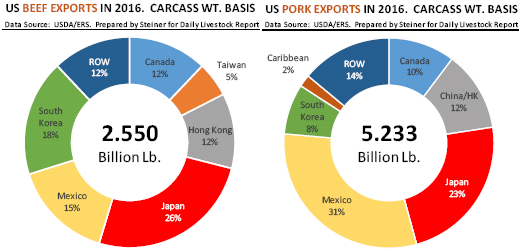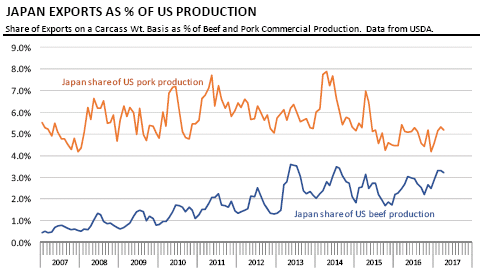



CME: Japan-EU EPA Shows Potential to Impact US Beef, Pork Trade
US - In the weekend DLR issue we gave an update on the status of US beef, pork and chicken exports in May (they were up) and what the latest weekly export data implies for the volume of trade in June and July, writes Steiner Consulting Group, DLR Division, Inc.Today, however, we thought it would be appropriate to cover a development that has the potential to negatively impact US beef and pork trade for many years to come, namely the Economic Partnership Agreement (EPA) between Japan and the European Union.

We say it has the potential not that it will immediately impact our trade since the principle agreement will be slowly implemented over a number of years.
Still, this agreement and the previous Free Trade Agreement between Japan and Australia put US livestock producers at a significant disadvantage, with US product facing stiff tariffs while tariffs on product from our main competitors slowly fade away.
Japan is one of the largest buyers of US beef and pork, accounting for 26 per cent of all US beef and veal volume in 2016. In 2016, the value of all US beef and beef variety meats sold to Japan was a little over $1.5 billion.
Pork exports to Japan in 2016 accounted for about 23 per cent of the entire volume exported. The combined value of US pork and pork variety meats in 2016 was almost $1.6 billion. The recent EPA between Japan and the EU will phase out a number of tariffs/duties that EU products currently face when coming into the Japanese market.

Interestingly, many of the provisions for lowering tariffs between Japan and EU are almost the same as what the US would have received as part of the TPP negotiations. For those interested in reading the text of the principle agreement and all that’s involved, you can find it following this link.
We reached out to our friends at the US Meat Export Federation (USMEF) who follow these matters closely. They explained that in the case of beef, the Japan/EU EPA agreement stipulates that "the duty of 38.5 per cent will drop initially to 27.5 per cent and then will be phased down to 9 per cent over 15 years. Duties on variety meats will also be slashed initially, for example tongues at skirts at 12.8 per cent will be reduced to 6.4 per cent and then phased to zero by year 11 and year 13, respectively."
Japan will continue to maintain safeguard levels in place, i.e. a specified volume of product is allowed to come in at specified tariffs. Once that volume is filled, all additional product will be assessed a higher tariff. The point on Japanese safeguards is one we have discussed many times during the years and it has the potential to become an issue once again this year.
A recent report from USMEF indicated that there is a risk the beef safeguard for imported frozen beef in Japan may be triggered at the end of July. Australian frozen beef exports to Japan in May were 18.8 per cent higher than the previous year and June exports to Japan were 23.5 per cent higher than a year ago. Similarly US beef exports to Japan have been increasing in double digits as well.
If the safeguard is triggered, USMEF notes that "the 50 per cent duty on US frozen beef will be in effect through March 2018, or the end of the current Japanese fiscal year. Under the terms of the Japan-Australia Economic Partnership Agreement (JAEPA), the duty on Australian frozen beef will remain at 27.2 per cent, as Australian beef is subject only to a separate annual safeguard."
This is important and something market will pay close attention to later this month.
USMEF does not expect the Japan/EU agreement to have much impact on sales of fresh/frozen US pork, at least initially. What will be impacted in the short term are sales of US cooked pork as tariffs for those items will decline sharply in the next five years.
Cooked US ham, bacon a ground pork will be at a significant disadvantage relative to competing products from EU countries. In the long term, the agreement is negative for US pork exports as some of the tariffs currently assessed for product coming under safeguard levels will be phased out over time.








